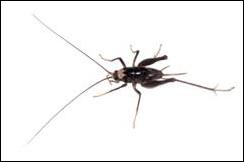New weta species found on Denniston Plateau
Friday 30 November 2012 – Wellington
Forest
& Bird media release for immediate
use
New weta species found on
Denniston Plateau
 A new species of cave weta has been
discovered on the West Coast’s Denniston Plateau, which,
if an Australian mining company has its way, will also be
the site of a 190ha open-cast coal mine.
A new species of cave weta has been
discovered on the West Coast’s Denniston Plateau, which,
if an Australian mining company has its way, will also be
the site of a 190ha open-cast coal mine.
The weta has been informally named the “Denniston white-faced weta” for its distinctive white markings behind its head. It was discovered on the plateau in March by Massey University evolutionist Steve Trewick, who was immediately struck by the weta’s unusual appearance.
“It just stood out. We haven’t seen anything with that appearance and colouration.
“Males and females are almost black with an unusual, prominent white marking behind their head,” he says.
Members of Massey University’s ‘Phoenix’ evolution, ecology and genetics group, led by associate professors Steve Trewick and Mary Morgan-Richards have been researching and classifying the weta.
Distinctive DNA sequence, the combination of spines on the legs and the shape of the females’ subgenital plate all indicate this is a species new to science. But Steve Trewick says more work needs to be done to determine the genus and whether it is endemic to the Denniston Plateau.
“This weta might occur elsewhere as well as Denniston, but what it highlights is that destroying distinctive habitat is likely to destroy biodiversity even before we know it is there. If we’re destroying biodiversity before we’ve even identified it, we’re clearly following the wrong strategy,” he says.
The plateau’s unique geological composition in combination with atypical weather conditions, including an annual rainfall of 6m, has created ecosystems that support wildlife found nowhere else in the world.
Forest & Bird’s Top of the South Field Officer Debs Martin says the discovery illustrates the rich ecological tapestry of the plateau and underscores why the plateau must not be mined.
“This new weta highlights the fact that the plateau is an incredibly diverse place that we don’t know a lot about. Laying waste to such a unique area of New Zealand that’s protected as conservation land would be a travesty,” she says.
A new species of day-flying moth, the Avator Moth, was also discovered on the plateau earlier this year.
ENDS


 Business Canterbury: Urges Council To Cut Costs, Not Ambition For City
Business Canterbury: Urges Council To Cut Costs, Not Ambition For City Wellington Airport: On Track For Net Zero Emissions By 2028
Wellington Airport: On Track For Net Zero Emissions By 2028 Landcare Research: ANZAC Gall Fly Release Promises Natural Solution To Weed Threat
Landcare Research: ANZAC Gall Fly Release Promises Natural Solution To Weed Threat NZ Anti-Vivisection Society: Auckland Rat Lovers Unite!
NZ Anti-Vivisection Society: Auckland Rat Lovers Unite! University of Canterbury: $1.35 Million Grant To Study Lion-like Jumping Spiders
University of Canterbury: $1.35 Million Grant To Study Lion-like Jumping Spiders Federated Farmers: Government Ends War On Farming
Federated Farmers: Government Ends War On Farming



